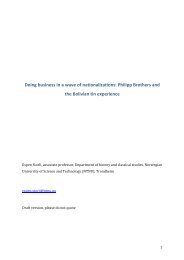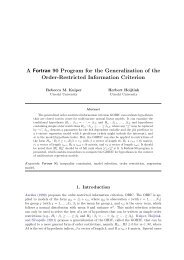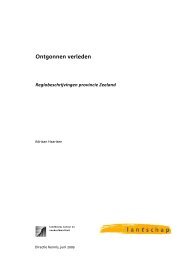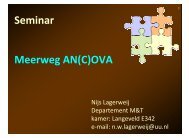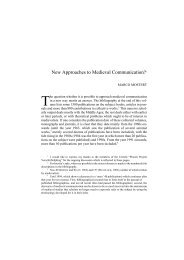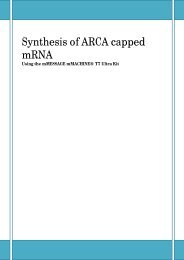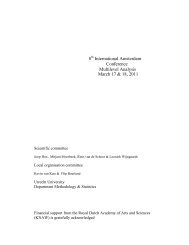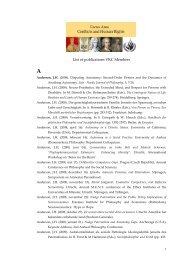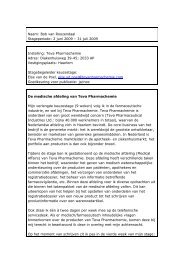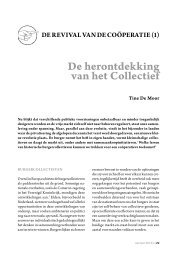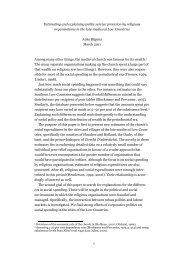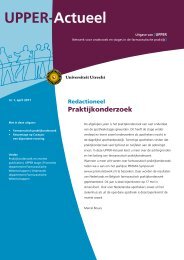CH8.Ewout Frankema.education.pdf
CH8.Ewout Frankema.education.pdf
CH8.Ewout Frankema.education.pdf
- No tags were found...
You also want an ePaper? Increase the reach of your titles
YUMPU automatically turns print PDFs into web optimized ePapers that Google loves.
State and Missions: The comparative development of <strong>education</strong> and itsimpact on state governance in the Congo and Indonesia since c. 1900Ewout <strong>Frankema</strong>, Utrecht UniversityWorkshop on Colonial Exploitation and Economic Development: The Belgian Congoand the Dutch East Indies Compared.University of Antwerp, 7-8 October 2011.Preliminary work, please do not quote.AbstractThis chapter compares the nature of a state versus mission-based colonial <strong>education</strong>system and its impact on long term economic development. The principle argumentdeveloped here is that the opportunities for indigenous children to attend a full Westerncurriculum of primary, secondary and tertiary <strong>education</strong>, however small they remained,enabled a tiny group of Indonesians to develop the intellectual leadership qualitiesrequired to manage an independent state. The racial segregation policies in BelgianCongo prevented access of Africans to the higher ranks of state administration and,mutatis mutandis, modern forms of higher <strong>education</strong> until a few years beforeindependence. This difference in <strong>education</strong>al and governance experience is one of thefactors that can clarify the contrast in macro-economic policy design under Suharto andMobutu in the late 20 th century.0
stability. Stability of prices, of economic institutions (including financial marketinstitutions) and government spending programs is vital to create and sustain afavourable investor’s climate and optimize conditions for private entrepreneurship.Education plays a role in the design of macro-economic policies in two ways. On theone hand it develops the administrative and intellectual capacity to implement incentivestructure enhancing policies. On the other hand, <strong>education</strong> can mitigate the negativeside-effects of kleptocratic rule.When the state is controlled by a dominant coalition of rent-seeking elites who areoverwhelmingly occupied with the preservation of personal interests, state policies tendto limit access to economic resources and political influence to the majority of thepopulation (Khan, 2000; North et al., 2009). Rent-seeking can impede economicdevelopment in various degrees, depending largely on the type of economic distortion itproduces. High transactions costs deter economic initiatives and impersonal exchange.A large group of non-coopted intellectuals raises the probability of certain formal andinformal checks on overt power abuse. Intellectuals more often take the lead in theorganisation of political opposition and are usually capable of communicating their callfor civil liberties (e.g. freedom of speech and public assembly, independent jurisdiction,political representation etc.) in a more effective way (Hall et al., 1986).For the latter reason colonial governments stood ambivalent towards the expansion ofindigenous <strong>education</strong> and the supply of higher <strong>education</strong> in particular. Colonialgovernments needed skilled employees in order to develop administrative capacity, thepublic health care system, to maintain and employ their communication andtransportation networks, but they also feared a contra-productive rise of anti-colonialsentiments. In the 1910s and 1920s Dutch politicians openly ventilated their concernsabout a white-collar proletariat in the East Indies that would threaten the stability ofcolonial society (van der Veur, 1969; Lelyveld, 1996). Similar concerns about theaccess of literate Congolese to subversive literature were expressed by the Belgians inthe Congo (Dunkerley, 2009). Indeed, many authors have stressed that the supply ofWestern <strong>education</strong> has been a significant factor in the rise of anti-colonial nationalism(Coleman, 1954; Sutton, 1965; White, 1996).2. State and missions: different objectives, different approachesTo Leopold the Belgian missionary societies were of great use to establish control overthe vast Congo territory. The Catholic missionary schools were needed to train peoplefor the army (La Force Publique) and for the lower ranks in the governmentadministration. Belgian missionaries also acted as crucial knots in the communicationand information network which upheld Leopold’s skeleton administration, them oftenbeing the only whites in the far corners of his private estate. The fact that Leopoldhimself never dared to visit his colony for fear of catching a tropical disease (vanReybrouck, 2010) nicely illustrates how vital the development of early mission stationswas to the effective occupation of the Congo territory.To secure British support for his Congo claim at the Berlin conference Leopold had toguarantee free entry to missionaries of all denominations, including the Protestant3
societies (Pakenham, 1992). Although the Protestant societies worked mainly outsidethe orbit of the colonial administration, their presence had important consequences forthe missionary schooling potential that was to develop in later years, especially after theannexation in 1908. The improved prospects of long term political stability enhancedthe influx of Catholic and Protestant missionaries competing for converts. The newadministration supported this development. Missionaries provided important publicservices such as <strong>education</strong> and (primitive forms of) medical care at very low costs,which was welcome in view of the extremely limited government budgets of theCongolese colonial state. Moreover, the Christian churches had access to a far greaterlabour potential which it could mobilize for an adventure in the tropics than the colonialgovernment.The ultimate goal of the missionary zeal was the conversion and salvation of as manyindigenous souls as possible. The missionary effort thus supported a widespreaddiffusion of mass <strong>education</strong>, with low quality standards and limited opportunities toenroll in a post-primary school trajectory. In the distant rural areas mission schools weregenerally ungraded and managed by one or two native missionary-teachers with acurriculum confined to the lower grades of primary <strong>education</strong>. Post-primary <strong>education</strong>was offered in the larger cities, but focused on teacher training programs in order toenlarge the group of indigenous missionary-teachers. The missions thus formed anextremely efficient medium to civilize and socialize colonial subjects without raising aclass of indigenous intellectuals that could challenge the legitimacy and authority of thecolonial state.The disadvantages of this system became apparent only in the course of time. Thedemand for high skilled native labour increased with the expansion of the stateadministration and the development of industrial production in the major copper areas(Katanga). The public call for increased government involvement in African <strong>education</strong>,endorsed by the report of the Phelps-Stokes committee in 1925, rose the pressure oncolonial governments to increase <strong>education</strong> budgets. The conflict over <strong>education</strong>alaffairs between the state authorities and the missions which arose during the 1920s weresustained until decolonization. The political weight of the Belgian Catholic church hadalways been considerable and traditional privileges proved hard to give up. Hence, themissions firmly resisted the plan to introduce state inspection in return for additionalfinancial support. The state program of lay <strong>education</strong> that was developed after WWIIwas attacked by the Church for its supposed support to condemnable atheisticideologies, such as communism (Depaepe and van Rompaey, 1995).In the Dutch East Indies the power-contest between the state and the, predominantlyProtestant, missions had been settled long before. In the last quarter of the 19 th centuryaround a quarter of the students in ‘recognized schools’ on Java and Madura attended amission school (zendingschool) and in the Outer Areas the mission schools formed themajority (Hartgerink, 1942, p. 39). Yet, the financial resources of the missions werelimited and the colonial administration refused to hand out public subsidies to privateschools (bijzondere scholen), following the arguments that were put forward about theseparation between Church and state in the Schoolstrijd (1889-1917), a longstandingpolitical debate on the financial treatment of private religious schools. Since the 1870s4
the Dutch colonial government started to annex the mission schools that were unable tostay in business (Hartgerink, 1942).The Dutch thus embarked on a path towards a dual system of public <strong>education</strong>, in whichthe mission schools were tying up the loose ends and the Islamic schools were graduallyoutcompeted. 1 In this dual system European schools offered the standard Dutchcurriculum to children of European and Indo-European descent. These schools wereopen to the top layer of the Indonesian elites who closely cooperated with the Dutch.European schools prepared children for a career in the colonial administration andoffered access to higher <strong>education</strong> in the Netherlands. The public schools for thecommon people (Volksscholen) served as a basic and cheap alternative to Western<strong>education</strong> (Brugmans, 1938, pp. 302-317; Lelyveld, 1996), with the purpose to prepareIndonesians for a position in Indonesian society. As of 1907 the government launched acampaign to promote the development of village schools, the so-called desa schools,which became the major driver of enrolment rates between 1907 and 1940. Studentsenrolled in a program of three years primary <strong>education</strong> focusing on the elementaryprinciples of reading, writing and calculation in the vernacular. Possibilities to attain astandard vernacular curriculum of six years were gradually enlarged (Boone, 1996).In sum, the key similarity in the genesis of both colonial <strong>education</strong> systems was that itresponded to a growing call in European media and public opinion to ‘develop’ insteadof ‘exploit’ the overseas territories. And as we will see in the next section, it also clearlyresponded to a growing desire among the indigenous populations to acquire usefulknowledge, improve material living standards and explore new job opportunities. Thekey difference is twofold. First, contrary to the Belgians the Dutch were committed tosecular <strong>education</strong> forced by local conditions (Islam) and domestic political ideology(Schoolstrijd). Second, indigenous access to Western <strong>education</strong> in the Dutch East Indieswas very limited, but nevertheless slowly extended until independence. In the BelgianCongo the maintenance of racial segregation policies made it impossible for the childrenof the Congolese elites to engage in a full curriculum of modern primary, secondary andtertiary <strong>education</strong>.3. Comparing school enrolment rates, 1900-2000A comparison of school enrolment rates at the primary and post-primary levels providesdeeper insight in the effects of different <strong>education</strong>al policies on the expansion of<strong>education</strong>al access. Figure 1 shows the 20 th century evolution of gross primary schoolenrolment rates for the age group of 6-11 (the official school age in the postwar era inIndonesia and the Congo). The time-series for the Netherlands Indies are taken from vanLeeuwen (2007, pp. 264-6). These include the enrolment of Indonesians, Europeans(mainly Dutch) and other Asians (mainly Chinese), but exclude the children enrolled inthe unrecognized schools, which did not receive state subsidy. The bulk of theseunrecognized schools consisted of Islamic boarding schools (pesantren) and mosqueschools (madrasah). These schools offered classes in religious philosophy and spiritual1 In the first decade of the 20 th century the colonial government deliberately transferred part of its<strong>education</strong>al responsibility to the missions in some of the Outer Areas, such as the Moluccas, under thepromise of state subsidies (Hartgerink, 1942, pp. 141-149).5
training (meditation), Koran recitation (in Arabic), martial arts and a variety of manualskills (Steenbrink, 1974). Colonial governments were reluctant to recognize the‘traditional’ Islamic schools because they paid insufficient attention to the core ofWestern primary <strong>education</strong>: reading, writing (literacy) and calculus. The Christianmission schools were also criticized for their focus on religious training, albeit to alesser extent.In so far the Koran study enhanced literary abilities (and there is some evidence it did)the economic ‘side-effects’ of religious <strong>education</strong> cannot be neglected (Reid, 1988, p.218; van Leeuwen, 2007, p. 49). For comparative purposes it is necessary to have atleast some idea about the relative size of Islamic <strong>education</strong>. Combining the officialenrolment rates in the unrecognized sector reported in the Koloniale Jaarcijfers of the1880s (ca. 250.000-300.000) with Furnivall’s estimate of 1938 (ca. 450.000), I estimatethat the relative share of unrecognized schools declined from ca. 75% to 16% of officialprimary enrolment levels. The dotted line for Indonesia reflects this trend.Figure 1: Gross primary school enrolment rates (age 6-11) in Belgian Congo andthe Netherlands Indies, 1880-20001601401201008060402001880 1890 1900 1910 1920 1930 1940 1950 1960 1970 1980 1990 2000Indonesia Indonesia, incl. non-recognized schools CongoSources: For Indonesia (van Leeuwen, 2007); Jaarcijfers voor het Koninkrijk der Nederlanden(Kolonieën) 1880-192x and Statistisch Jaaroverzicht van Nederlandsch-Indië 192x-1939; (Furnivall,1943); UNESCO, Statistical Yearbooks, various issues 1964-1999; For Congo (Depaepe and vanRompaey, 1995, P. 247) and Annuaire Statistique de la Belgique et du Congo Belge 1911-1960.For the Congo the available data should be treated with even greater caution, especiallyfor the years between 1885 and 1930, when <strong>education</strong> statistics were not collected at all.Following the work of Liesenborghs (1939), Depaepe and van Rompaey (1995, p. 38 &6
247) put the number of students enrolled in 1908 at ca. 46.000, of which ca. 27.000were enrolled in Protestant and 19.000 in Catholic mission schools. What seems certain,however, is that the numbers increased spectacularly after 1908, to approximately100.000 in 1913, 150.000 in 1921 and 350.000 in 1929. For the period 1930-1960 theBelgian Annuaire Statistique provides annual accounts of the number and type ofschools and the number of students enrolled. For the post-colonial era I used the officialestimates presented in the UNESCO Statistical Yearbooks.Another major problem concerns the lack of reliable population data. Census takersfaced the sheer impossible task to survey immense hinterland areas without anydeveloped infrastructure. Moreover, the death toll due to the sleeping sickness pandemicand Leopold’s aggressive rubber policies, make it extremely difficult to estimate thesize of the population on the basis of backward extrapolation from postwar censusestimates. The short-cut I applied is to backward extrapolate the post-1950 populationseries with a fixed annual growth rate of 1.0%, which has just one advantage: it’stransparent. Therefore it’s good to know that changes in the assumed population growthrate (to 0,5 or 2%) will not alter the following main observations.First, there was a dramatic collapse of school enrolment rates in the Congo during the1980s and 1990s, after a decade of stagnation in the 1970s. This was just one of themany tragic effects of the social, political and economic deterioration whichcharacterized the major part of Mobutu’s thirty year’s rule. Exactly in this periodIndonesian gross enrolment rates started to exceed 100%, indicating that not only theaim of universal primary <strong>education</strong> was accomplished, but that it was also combinedwith a major reparation effort among higher age cohorts.Second, figure 1 shows that enrolment rates in the Belgian Congo surpassed enrolmentrates in the Netherlands Indies in the three decades between 1920 and 1950. In BelgianCongo the expansion of enrolment followed a gradual upward trend between 1910 and1970 with a few minor interruptions in the early 1940s (WWII) and the late 1950s(independence). In Indonesia the colonial era was set apart from the post-colonial era bya major trend break. Before 1940 gross primary school enrolment rates did not surpass20%. During the years of the Japanese occupation (1942-1945) enrolment rates evenhalved. The big push to mass <strong>education</strong> occurred right after the end Indonesia’sdeclaration of independence in 1945. Enrolment rates jumped from 20 to 80% of theschool age population in less than two decades between 1945 and 1962.Third, the relative success of the missionary approach in the Belgian Congo alsoappears from a broader African comparative perspective. Belgian Congo was part of aselect group of mainly British African colonies such as the Rhodesia’s (Zambia andZimbabwe), Nyasaland (Malawi) and Uganda with gross enrolment rates (age 5-14)surpassing 20% at the eve of the Second World War. This was higher than the BritishAfrican average (18.2%) and much higher than the French (5.4%) or Portuguese African(5.3%) average (<strong>Frankema</strong>, 2011). Primary school enrolment in the Dutch East Indies,on the other hand, fell considerably behind those of the neighbour countries such asBritish Malaya, Formosa (Taiwan) and the Philippines. In Thailand enrolment rateswere even three times as high as in the Netherlands Indies (Furnivall, 1943).7
ut formed a weak basis for the development of higher <strong>education</strong>, and especially tertiary<strong>education</strong>. The colonial government in the Dutch East Indies performed weakly inexpanding mass <strong>education</strong> from a comparative perspective, but I will argue furtherbelow that the public <strong>education</strong> system developed by the Dutch laid a more solidfoundation for indigenous access to ‘state of the art’ forms of higher <strong>education</strong>.4. The missionary effort in the CongoThe success of the missionary schooling effort in the Congo cannot be understoodwithout taking into account the presence of an exceptionally large number of Westernmissionaries. Oliver has estimated that the number of Christian missionaries in EastAfrica reached a maximum of 3.500 persons during the interwar years (Oliver, 1962,pp. 231-245). Table 1 shows that the number of foreign missionaries in Belgian Congowas not only higher already before 1940, but also continued to increase thereafter.These foreign missionaries were of course crucial for the rapid spread of missionsschools, but their presence also signals favourable local conditions for conversionpractices, regardless of the high health risks involved (malaria, sleeping sickness,yellow fever).As I have argued elsewhere (<strong>Frankema</strong>, 2011), the presence of foreign missionaries onlymade sense in areas with revealed local demand for missionary services. This was notself evident. Table 1 shows that the number of foreign missionaries increased with afactor 15, while enrolments rose with a factor 37 between 1908 and 1957. This was onlypossible because of a rapidly increasing involvement of native African missionaries. In1958 there were no less than 6.934 Protestant mission schools in the Congo and circa1.550 foreign Protestant missionaries. The majority of these schools were run byCongolese converts. Local demand for missionary services was a pre-condition for theAfricanization of the missionary effort.Revealed demand for missionary services in combination with the virtual absence ofinstitutional entry barriers created favourable conditions for denominationalcompetition. Belgian Catholic missionary societies became actively engaged in the raceagainst Protestant missions to conquer the ‘high-potential’ areas. The Congo colony wasBelgium’s only overseas possession (together with the official mandate over Ruanda-Urundi granted by the UN after World War I), which meant that the ratio of the colonialover the metropolitan population remained low. Belgian citizens with overseasambitions concentrated their efforts on the Congo colony and this especially appealed tothe large group of Belgian Catholic missionaries. Table 2 demonstrates that themetropolitan capacity, in terms of population size, may indeed have been a factor.Although Indonesia was a similar ‘single big colony’ for the Dutch, the differences indemography equaled the ratio the British were dealing with in the heydays of theirglobal empire.The large carrying capacity of the Belgian labour force, is also reflected in the numberof foreign (i.e. Belgian) administrators. Richens has shown that in a sample of 33African colonies in the late 1930s Belgian Congo counted by far the highest number:728 against an African colonial average of 94! In British Nigeria, with more than twice9
as many inhabitants, the number of administrators was less than half (353) (Richens,2009, pp. 21 & 64-5). These numbers conceal an important feature of Belgian rule inAfrica: they make clear how the Belgians managed to rule the single largest colonialterritory in Africa without depending on high ranked indigenous officials with majoradministrative responsibilities.Table 1: Absolute numbers and indices of missionary presence and studentsenrolled in Belgian Congo, 1908-1957 (1938 = 100)1908 1929 1938 1950 1957Foreign missionaries 500 2,500* 3,732 5,336 7,205Index 13 67 100 143 193School enrolment 46,000 350,000 562,851 970,372 1,718,931Index 8 62 100 172 305Sources: 1908 from (Stengers and Vansina, 1985); 1929 (Depaepe and van Rompaey, 1995); 1938-1957Annuaire Statistique de la Belgique et du Congo Belge 1911-1960.Notes: 1929 number of missionaries is guesstimate based on 1931 figures from Annuaire Statistique de laBelgique et du Congo Belge 1911-1960.Table 2: The ‘population support ratio’ in the British, Dutch and Belgian colonialempires, ca. 1938Metropolitanpopulation (1)(x 1000)Colonialpopulation (2)(x 1000)Populationsupport ratio1938 1938 2/1United Kingdom 47.5 358.1 7.5Netherlands 8.7 68.3 7.8Belgium 8.4 13.9 1.6Source: Statistical Abstract of the British Colonies 1938-1940; Maddison (2010).Nunn (2010) has recently argued in line with Johnson (1967) that the presence ofnavigable waterways, which were scarce in Africa, have had a positive impact on thespread of missions. Johnson has shown that the diffusion of mission stations closelyfollowed the upstream courses of the Congo river and its many tributaries. Watertransport allowed missionaries to travel back and forth in a relatively efficient way andfacilitated the delivery of the necessary supplies (school, medical, food, bibles etc.).African communities were naturally attracted to the river and often economicallydepended on it. The role of such geographical advantages should not be overstated,however, especially in view of the great risks missionaries were willing to take bysettling in the tropics. Moreover, the big population centers in Indonesia were also easyto access for foreign missionaries, but the cultural and institutional constraints wereeventually decisive for their limited settlement.The strength of the missions in spreading <strong>education</strong> had much to do with theirefficiency and flexibility: short lines of communication, high levels of personalresponsibility entrusted to the people in the field, low levels of labour remuneration and10
a strong, religiously motivated, spirit to endure. Colonial bureaucracies worked in adifferent way and this is one of the reasons why enrolment rates in the Dutch EastIndies grew at a slower pace, despite the much longer tradition of supplying formal<strong>education</strong>. Bureaucracies are designed to control, to work within delineated budgets anddirectives and, not unimportant, bureaucracies do not compete for converts. In theDutch East Indies the teachers of the desa-schools had to fulfill a number of teacherqualifications in order to be liable to a state salary. Teacher training schools (dekweekscholen) gradually expanded, but the pool of qualified students remained small.Moreover, the state had to provide official permission for the establishment of a newschool if it was to receive state subsidies to pay for qualified and salaries teachers. Therequired investments, inspections and feedback procedures took time. This alsosuggests, however, that the quality standards in the public <strong>education</strong> sector in Indonesiawere higher than in the Congo. Is there any evidence for this hypothesis?5. The role of quality standards in <strong>education</strong>When investigating the comparative development of <strong>education</strong> in the Congo andIndonesia one is immediately confronted with the great differences in the collection of<strong>education</strong> statistics. Since the late 19 th century the Dutch colonial government recordedthe number of schools, the type of schools, the number of students in school per gradeand the percentage of children that left school with a certificate. This percentage wasextremely low in the late 19 th century but improved quickly as more children continuedtheir career into the third grade (Hartgerink, 1942: pp. 88-89, 136-137). These statisticsalso reveal that the desa-schools on Java and Madura performed significantly better thanin the Outer Areas. Yet, the simple fact that this information was collected on a centrallevel indicates the degree of control that was exercised on quality improvement. Themission schools in the Congo enjoyed a much larger degree of freedom because therewas no central authority imposing and monitoring prescribed curricular standards.The population census executed in respectively 1961 (Indonesia) and 1962 (Congo)suggests that the <strong>education</strong> system in Indonesia was more effective in raising literacyrates, despite the fact that the proportion of school-age children enrolled in the Congobetween 1920 and 1950 was considerably higher. In Indonesia the literacy rate of thepopulation aged 15+ was 42.9 against 31.3 in the Congo (UNESCO, 1965). The genderdistribution was highly unequal in both countries: 57.2 (M) versus 29.6 (F) in Indonesiaand 49.0 (M) versus 14.0 (F) in the Congo. The literacy rates of consecutive Indonesianage cohorts reveal a steady improvement since the first decade of the 20 th century. Tenyear age cohorts which had reached the age of 15 in respectively the 1910s, 1920s and1930s showed an increase in literacy rates of respectively 5.1, 6.7 and 10.8 compared tothe preceding age cohort. After the 1940s these rates improved even faster. The cohortof children attending primary school during the 1950s had a literacy rate in 1961 of72.1% with a more egalitarian gender distribution.A comparison of government expenditure patterns provides further insight in possiblequality differences. Between 1900 and 1940 the Dutch government gradually increasedits investments in <strong>education</strong> from 2 to 5% of the total expenditure budget. From a globalcomparative perspective this share was far from impressive (<strong>Frankema</strong>, 2011), but it11
was much more than in the Congo. Figure 3 shows <strong>education</strong>al expenses per head of thepopulation converted to current US $ using official exchange rates. This is a rathercrude measure, because exchange rates can deviate substantially from purchasing powerparities and fluctuated heavily especially in the 1930s. Yet, the size and consistency ofthe gap in expenditure leaves little doubt that the difference was significant indeed.Prior to 1940 expenses in the Congo remained below 10 dollar cents per head of thepopulation, which was roughly equal to the amount spend in the Indies before 1907.Between 1910 and 1940 the Dutch colonial government spent at least five times asmuch. Moreover, because enrolment rates in the East Indies were lower, the differencesin government expenses per student enrolled reached an average rate of 10 to 1 in thisperiod.Although the average amount of 10 US $ per student enrolled in the Netherlands Indieswas quite respectable, we have to keep in mind that the distribution around the averagewas highly unequal. In 1929, for instance, about half of the total <strong>education</strong> budget wasspent on European <strong>education</strong>, which was reserved for only about 10% of the totalenrolled (van Leeuwen, 2007). On the other hand, these government funds wereincreasingly absorbed by Indonesian and Chinese children as they started to outnumberthe European children in the Dutch secondary schools (Mulo, HBS, Medical colleges)during the 1920s (van der Veur, 1969p. 14). By the late 1930s ca. 75% of the studentsenrolled in post-primary <strong>education</strong> were of Indonesian or Chinese origin (van Leeuwen,2007).Figure 3: Per capita government expenditure on <strong>education</strong> in the NetherlandsIndies and Belgian Congo, 1880-1940 (in current US $)0.5IndonesiaCongo0.40.30.20.10.01880 1890 1900 1910 1920 1930 1940Sources: For Indonesia (van Leeuwen, 2007), van Leeuwen has included expenditure on the state leveland provincial level, as published in the reports of the Dutch Indies Education Committee; For CongoAnnuaire Statistique de la Belgique et du Congo Belge 1911-1960.Notes: Dutch florins and Belgian Francs converted to US Dollars using official exchange rates.12
For the Belgian Congo statistics do not allow for a breakdown between expenses onEuropean <strong>education</strong> and subsidies to the Catholic mission schools. But it is clear that themissionary societies remained its primary financiers, at least until WWII. Protestantmissions received no subsidies until 1947 and among the Catholic schools governmentfunds were distributed rather unequally, with a strong bias towards the schools in themajor urban centers. These central schools had to be better equipped because of theirstrategic importance: they trained the next generation of clerks and typewritersnecessary for administrative tasks, the medical assistants, technicians and agriculturalexperts necessary to develop the rural economy and also the catechists and soldiersnecessary to evangelize and secure order (Depaepe and van Rompaey, 1995, pp. 63-69).The financial involvement of the Belgian Catholic missions in the Congo played acrucial role in the 1925 convention with the Belgian state. The catholic schools wouldreceive more financial support in exchange for extra efforts to spread mass <strong>education</strong>across the colony. The contract was not signed until 1929, however, because themissions rejected the proposal of a state inspection that would monitor and guaranteethe quality of colonial <strong>education</strong>. The fact that the Catholic missions eventually wonthis battle tells a lot about the balance of power: the Catholics exerted a de factomonopoly on the development of colonial <strong>education</strong> which they held on to until 1948(Depaepe and van Rompaey, 1995, pp. 60-63).Yet, the rise in government expenditures during the second half of the 1920s onlysufficed to meet the increasing costs of enrolment expansion. And there is much reasonto assume that the financial hardship even increased during the interwar years. Thenumber of mission schools and students expanded at a much faster rate than thedomestically raised funds of the Christian missions. Local communities thus had tomake substantial contributions in kind, such as food, clothing or the supply of unpaidlabour on the mission fields or in construction work. Agricultural field work was astandard part of the curriculum in the rural mission schools and served a doublepurpose: it helped to teach discipline, docility and structure, while it generated anadditional source of revenue to finance local missionary activities. Girls’ <strong>education</strong>focused on housekeeping skills, child care, hygiene and the importance of suchChristian values as monogamy.In the Dutch East Indies money also made the difference. The quality gap between theIslam schools, mission schools and desa-schools on the one hand and the Europeanschools (gouvernement scholen) was obvious. The applications for Dutch languageschools were far higher than the available seats. European schools could hire bettertrained teachers, reduce class size and buy more advanced teaching equipment. Fromthe Koloniale Jaarcijfers (1934) it appears that pupil-teacher ratios were considerablylower in the European schools: in 1932-33 they counted 31.6 pupils per teacher against49.4 in the desa-schools and 50.7 in the Dutch-Chinese schools.Yet, in both colonies the village schools provided the backbone of mass <strong>education</strong>. Thekey distinction between the desa-schools in Indonesia and the rural mission school inthe Congo relates to the secular nature of the curriculum in the former and the emphasison religious and moral instruction in the latter. In the desa-schools reading and writing13
(in the vernacular) and calculus formed the core subjects. The curriculum wasstandardized, graded and subject to state inspection. The primary objective of themissions in Congo was to spread Christianity. Concerns to ‘overeducate’ the nativepopulation existed in both colonies, but with a crucial difference: in the Congo themissionary-teachers themselves experienced a tension between advanced <strong>education</strong> andsocialisation, in the Indies these concerns were especially held by the Dutch colonialelite, but not so much by the Indonesian teachers who supplied the <strong>education</strong> inpractice.6. Education for self-determinationThe Japanese occupation of the Dutch East Indies (1942-1945) contributed much to thediffusion of strong anti-colonial sentiments among the Indonesian population. TheJapanese occupation uncovered the military and political weaknesses of the Dutch. Thelarge scale mobilization of the Indonesian youth in the armed forces under Japanese ruleconnected an enormous amount of human energy to revolutionary ideas and militarymeans of power. Moreover, the tyrannical rule of yet another distrusted foreign powerendorsed the desire among the Indonesian people to determine their own future. Indeed,the declaration of independence in 1945 was a logical consequence of the retreat of theJapanese.The spirit of independence and revolution unleashed an enormous demand forschooling. Mass <strong>education</strong> now opened the doors to socio-economic mobility which hadremained closed for as long as people remembered. Job opportunities in the civilservices expanded enormously and were highly attractive to students and formersoldiers. Politicians were eager to hand out higher income jobs in turn for politicalsupport. The Indonesian language became the standard throughout the <strong>education</strong> systemand was also used in all official communications of the state and the mass media. It isone of the major accomplishments of the early Sukarno regime that they managed tofacilitate this great expansionist wave without a complete overhaul of the system. Graderepetition and pre-completion drop-out rates remained very high in primary <strong>education</strong>(ca. 60% in the 1950s), but they did not prevent the progress of a rapidly growing groupof students into secondary and tertiary <strong>education</strong> (Ricklefs, 2008: p. 274-5).Universities were erected in various parts of the country and some of these institutionsachieved respectable standards. The roots of the University of Indonesia (UniversitasIndonesia), which is one of the top rated institutes, go back to a school for medicalassistants established in 1851. In 1898 the colonial government transformed this schoolinto STOVIA (School tot Opleiding van Inlandsche Artsen) with the purpose to trainhighly specialized medical doctors. The <strong>education</strong> program consisted of 9 years andcombined aspects of high school and university <strong>education</strong>. The Bandung Institute ofTechnology, another top institute, is the oldest technology-oriented university inIndonesia and evolved out of the Technische Hoogeschool in Bandung established in1920.The early graduates of these institutes were to fulfill a key role in Indonesia'sindependence movement. Sukarno himself was very much the product of the Indo-14
European school tradition. His father was a desa-school teacher at Java. Sukarno firstcompleted three years of primary <strong>education</strong> in the vernacular and continued at aEuropean primary school. In 1915 he attended the Hogere Burger School (HBS), whichrepresented the highest level of Western secondary <strong>education</strong>. In 1920 he joined theTechnische Hoogeschool in Bandung and was among the first students to graduate as anengineer in 1925. No doubt, his long background in Western higher <strong>education</strong> endorsedhis ideas about the importance of <strong>education</strong> for self-determination, both on a personal aswell as a national level (Giebels, 1999). Mohammed Hatta pursued a similar route.After his secondary school in Batavia he travelled to the Netherlands to studyeconomics and business at the Handelshogeschool in Rotterdam (currently the ErasmusUniversity) and stayed for 11 years (1921-1932). Exactly in this period Hatta started tocampaign for non-cooperation and mass-actions against the colonial oppressor,activities for which he was detained in the Netherlands and later again in Indonesia, formore than six years.The key figures dominating the political scene during the early years of independence inthe Congo had a very different background. They grew up in a time when thesegregation policies were strictly maintained. The closed access to higher offices in thecolonial administration or the key position in international commerce or the miningindustry, implied that there was little need to offer higher levels of non-vocationaltraining to the indigenous population. The intellectual development of the later politicalleaders was therefore largely shaped by the jobs and positions they were to fulfill.Lulumba, Kasavubu, Mobutu and Tshombe all attended a mission school for theirprimary <strong>education</strong>. Lulumba’s highest degree was a one year course at the governmentpost office training school. He started his working career as a postal clerk and atravelling beer salesman. Kasavubu was trained as a teacher at a Cathcolic missionaryschool. Mobutu’s <strong>education</strong>al career was completed at the Ecole Centrale des Sous-Officiers in Luluaburg, where he followed a two year’s course on accounting andsecretarial work. Thsombe was trained as an accountant and pursued the business careerof his farther in the Katangese retail sector (ref.).Black children began to be admitted to European secondary schools only from 1950onward and their numbers remained very small. The first university in the Congo, theLeuven University, was founded near Léopoldville in 1954. It admitted black studentsfrom the start, but the first cohorts of Congolese still had to complete secondary school.In 1956 a state university was established in Elisabethville (Mantels, 2007). Hence, atthe eve of independence in 1960 just a handful of Congolese were enrolled in tertiary<strong>education</strong> and even fewer actually held a university degree. Most of the students wereenrolled in the humanity and social science faculties, but not in the technical faculties.In 1960 there were 13 students at the tertiary level enrolled in natural sciences, 18 inengineering, 71 in the medical sciences and 26 in agricultural sciences. Together thisgroup formed 30% of a total of 423 tertiary enrolled and the majority consisted ofEuropean, rather than Congolese, students (UNESCO, 1965; Mantels, 2007).Various accounts of the negotiations on the conditions for independence at the roundtable conference (ronde tafel conferentie) in Brussels in 1960 stress the gap in politicalcunningness between the young group of Congolese representatives and the hautecoutureof Belgium’s professional politicians (Etambala, 1996: pp. 31-33; van15
Reybrouck, 2010: pp. 278-280). The Congolese delegation was advised by severalBelgian’s who had a much higher <strong>education</strong> than the delegates themselves. TheCongolese held jobs as accountant, clerk, journalist, school teacher or tradesmen. Onlya few of them held positions with the type of responsibilities that require an accurateoverview of overarching national political and economic interests. Naivety was also themajor reason why the Congolese transition government agreed with the Belgiangovernment to dissolve the Comité Spécial du Katanga, which formally left the newCongolese state with just a minority share in the Union Minière, the biggest miningcooperation in the country (van Reybrouck, 2010: p. 279).Just about the time when Mobutu conquered the stage in the Congo to stay in power formore than three decades (1965-1997), Suharto, the army general, displaced Sukarno.Suharto stayed in power for a similar period (1967-1998). Suharto and Mobutu rankamong the most cruel and conscienceless dictators of the 20 th century. They have beenresponsible for mass murders and their appetite for self-enrichment has becomelegendary. Their methods were similar: by monopolizing the most profitable industriesof the country (copper, oil) they managed to become the wealthiest person in no time.Both dictators controlled power by combining an extensive system of politicalpatronage, a firm control over the army and keeping up a credible threat of terror againstpolitical opponents. Both received support from the Western world (especially the US)for their outspoken anti-communism.However, the economic policies of Mobutu’s “Mobutuism” and Suharto’s “New Order”revealed sharp contrasts, not only in name. Suharto managed to combine rent extractionfor his personal clientele with an impressive record of macro-economic growth, fromwhich a vast majority of Indonesians eventually reaped the benefits. Few doubt that themacro-economic policies of Suharto’s government have positively contributed to thestructural transformation of the Indonesian economy and the rapid reduction of urbanand rural poverty rates (Booth, 1998; Hill, 2000; Dick et al., 2002; <strong>Frankema</strong> andLindblad, 2006; Thee, 2006; Warr, 2006). With the benefit of hindsight the start of theSuharto era in Indonesia can be regarded as a structural break with a period of recurrentinflation, increasing state debt, declining foreign exchange reserves and prolongedeconomic stagnation (Glassburner, 1971).Mobutu’s plans to develop the economy were marked by bright prospects in the firstyears, but failed miserably in the long run. Yet, fifteen years after the fall of Mobutu theCongolese are still waiting for the first signs of structural economic improvement.The success of Suharto’s economic program and the failure of Mobutu’s cannot be fullyexplained by just a personal difference in economic insight. Suharto assembled a teamof experts to get the economy back on track in a deliberate attempt to restore socialorder. These experts were capable of translating the New Order’s development trilogy“growth, stability and equity’ into a range of clearly defined objectives focusing on theachievement of self-sufficiency in food production (rice) and, subsequently, on anintensive program of industrialization based on Indonesia’s comparative advantages(labour abundance) (Thee, 2006). Suharto not only benefitted from the fact that thenecessary expertise of well trained economists was available but also, at a much broaderlevel, that there existed a class of entrepreneurs sufficiently equipped with the16
knowledge and organizational capacities to realize the potential of modern technologyin the major sectors of the economy. So it seems that the Indonesian <strong>education</strong> systemhad better prepared Indonesian society for rapid development in both the technicaleconomic and political economic spheres.Mobutu was also aware of the importance of restoring economic stability for politicalsurvival in his early years and, like Suharto, squandered huge amounts of money onmegalomaniac projects which never offered the envisaged return (dams, steel mills,aircraft industry). The key distinction is that Suharto operated in a context of welltraineduniversity graduates, with whom he shared part of his power throughconsultation.Add paragraphs on Mobutu’s economic policies7. ConclusionYet to be written.References1934. Statistisch Jaaroverzicht van Nederlands-Indië over het jaar 1933. Landsdrukkerij, BataviaBirdsall, N., Ross, D., Sabot, R., 1997. Education, Growth and Inequality. in: Birdsall, N. andJasperson, F. (Eds.), Pathways to Growth. Comparing East Asia and Latin America, Inter-American Development Bank, Johns Hopkins University Press, Washington D.C., pp: 93-130.Boone, A. T., 1996. Onderwijs en opvoeding in de Nederlandse koloniën 1595-1975. PedagogischTijdschrift 21, 87-92.Booth, A., 1998. Indonesian Economic Development in the Nineteenth and Twentieth Centuries: AHistory of Missed Opportunities. Macmillan LondonBrugmans, I. J., 1938. Geschiedenis van het Onderwijs in Nederlandsch-Indië. Wolters, GroningenClemens, M. A., 2004. The Long Walk to School: International <strong>education</strong> goals in historicalperspective. Center for Global Development Working Paper No. 37Coleman, J. S., 1954. Nationalism in Tropical Africa. The American Political Science Review 48,404-426.Depaepe, M., van Rompaey, L., 1995. In het teken van de bevoogding. De educatieve actie inBelgisch-Kongo (1908-1960). Garant, LeuvenDick, H., Houben, V. J. H., Lindblad, J. T., Thee, K. W., 2002. The Emergence of a NationalEconomy. An Economic History of Indonesia, 1800-2000. KILTV Press, Leiden17
Dunkerley, M. E., 2009. Education policies and the development of the colonial state in the BelgianCongo, 1916-1939. PhD-Thesis, University of Exeter, CityEtambala, Z., 1996. Het Zaïre van Mobutu. Davidsfonds, Leuven<strong>Frankema</strong>, E. H. P., 2009. The Expansion of Mass Education in Twentieth Century Latin America:A Global Comparative Perspective. Revista de Historia Económica 27, 359-395.<strong>Frankema</strong>, E. H. P., 2011. Colonial Taxation and Government Spending in British Africa, 1880-1940: Maximizing Revenue or Minimizing Effort? Explorations in Economic History 48, 136-149.<strong>Frankema</strong>, E. H. P., 2011. The Origins of Formal Education in sub-Saharan Africa: Was BritishRule More Benign? CGEH Working Paper No. 5<strong>Frankema</strong>, E. H. P., Lindblad, J. T., 2006. Technological Development and Economic Growth inIndonesia and Thailand since 1960. ASEAN Economic Bulletin 23, 303-324.Furnivall, J. S., 1943. Educational Progress in Southeast Asia. Institute of Pacific Relations, NewYorkGiebels, L. J., 1999. Soekarno. Biografie. Bakker, AmsterdamGlassburner, B., 1971. Indonesian Economic Policy after Sukarno. in: Glassburner, B. (Eds.), TheEconomy of Indonesia. Selected Readings, Cornell University Press, Ithaca, pp:Hall, R. L., Rodeghier, M., Useem, B., 1986. Effects of Education on Attitude to Protest. AmericanSociological Review 51, 564-573.Hartgerink, H. J. H., 1942. De Staten-Generaal en het Volksonderwijs in Nederlandsch-Indië, 1848-1918. Wolters, GroningenHelpman, E., 2004. The Mystery of Economic Growth. The Belknap Press of Harvard UniversityPress, Cambridge MAHill, H., 2000. The Indonesian Economy. 2nd Edition, Cambridge University Press, Cambridge UKJohnson, H. B., 1967. The Location of Christian Missions in Africa. Geographical Review 57, 168-202.Khan, M., H., 2000. Rents, Efficiency and Growth. in: Khan, M. H. and Jomo, K. S. (Eds.), Rents,Rent-Seeking and Economic Development. Theory and Evidence in Asia, Cambridge UniversityPress, Cambridge MA, pp: 21-69.Kuznets, S., 1966. Modern Economic Growth. Rate, Structure and Spread Yale University Press,New HavenLelyveld, J. E. A. M., 1996. Koloniale pedagogiek in Nederlands-Indië. Pedagogisch Tijdschrift 21,101-114.Liesenborghs, O., 1939. Het Belgisch Koloniaal Onderwijswezen. Vlaamsch OpvoedkundigTijdschrift 21, 448-490.18
Thee, K. W., 2006. Policies Affecting Indonesia's Industrial Technology Development. ASEANEconomic Bulletin 23, 341-359.UNESCO, 1965. Statistical Yearbook 1964. UNESCO, Parisvan der Veur, P. W., 1969. Education and Social Change in Colonial Indonesia. Progress andProcrastination in Education in Indonesia prior to World War II. CIS Papers in InternationalStudies, Southeast Asia Series no. 12, Ohio University Cityvan Leeuwen, B., 2007. Human capital and economic growth in India, Indonesia and Japan. Aquantitative analysis, 1890-2000. PhD thesis, Utrecht University, Utrechtvan Reybrouck, D., 2010. Congo. Een Geschiedenis. De Bezige Bij, AmsterdamWarr, P., 2006. Poverty and Growth in Southeast Asia. ASEAN Economic Bulletin 23, 279-302.White, B. W., 1996. Talk about School: Education and the colonial project in French and BritishAfrica (1860-1960) Comparative Education 32, 9-25.20



